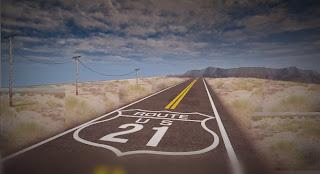Workin on this scene in UDK to test out deserty/road type scenarios for an as yet unannounced project :P
So this is the kinda thing I'm shooting for, mocked up with a little photoshop.

So there will be a bunch more props to make, like this telegraph pole,
but the most interesting thing is the road material.
Whilst the road markings like the yellow lines are done with decals, all the rest of the textures are tiling textures, blended with vertex paint.
Heres a peak at the material, and a breakdown of how it works.
The big chunk on the bottom is straight out of this tutorial: http://www.chrisalbeluhn.com/UDK_Advanced_Vertex_Painting.html, which I use to make the transition between the two different desert textures look nice.
The other advantange of this technique is that it works with much lower density meshes whilst still looking good, as the differences are modulated with a texture.
Another thing I used that I stole from that tutorial was simply plugging the vertex colour for the asphalt texture into a power node and a constant clamp, which makes it a much sharper edge transition. It would have been nice to rough up the asphalt edges in the same way as the cracked sand transition, but I don't think it's really necessary, especially as I plan to cover it up with some simple roadside props and foliage.
The other interesting thing about the material is that I use WorldPositionOffset to make those hilly bits in the distance. It's nice to be able to paint those hills on quickly and easily with the Vertex Paint tool.
The disadvantage of World Position Offset is that it doesn't affect the collision, or properly accept decals. I had intially used it to make the asphalt a little raised up, but without collision or decals, it looked a little silly.
Because I made some of the material before I fully understood WorldPositionOffset, I had to convert the Red vertex colour into a blue constant, as the colour input to the WorldPositionOffset defines which direction the mesh is offset. To do this, I masked out the Red channel, and multiplied it by a constant3vector of 0,0,1, which turned it into a blue constant.
The next steps will be a handful of extra props, distant mountains, decals to break up the monotony of the road (oil stains etc.), and of course, foliage. Lots of foliage. I haven't ever really done any foliage, so that should be a nice challenge.





